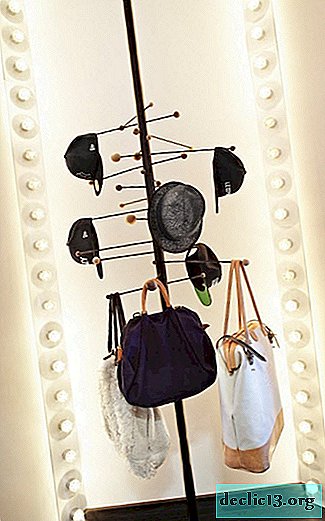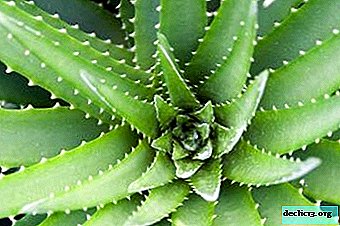What you need to know about caring for clerodendrum at home and how does the plant look in the photo?

Klerodendrum (often mistakenly called it “clerodendron” by analogy with “rhododendron”) is a multi-annual plant from the Verbena family, originally from the Canary Islands. It is tree-like and shrubby, deciduous and evergreen. Florists admire its magnificent aroma, which comes from flowers and leaves, and each variety has its own.
It is ideal for vertical gardening, but in order to decorate the unattractive wall of the garage in the country or a corner on the balcony, they spend a lot of time and effort on caring for it. How to grow a neat tree or a beautiful vine with flowering shoots? How to trim at home?
Growth Features
Flowering varieties of clerodendrum are grown on the windowsills.. They have simple leaves. They are heart-shaped, and their edge is serrated or even. The arrangement of leaves on the stem is opposite. They have an uneven, "quilted" surface, as they have many deeply pressed veins. Color is deep green. If the conditions are suitable, then in spring flowers will blossom on the tops of young shoots. The ovary will appear on an erect peduncle formed by panicles or scutes. Each flower has a bell-shaped, five-lobed calyx, from which elongate stamens protrude.
ATTENTION: The main feature of the plant is the need for formation. If you do not prune and pinch it regularly, the clerodendrum does not bloom beautifully and abundantly. You can not leave it unattended during a period of active growth.Where should the pot stand?
A pot with clerodendrum is placed on a western or eastern window. If the grower puts it on the south window, the leaves on it will turn yellow and fall off. This is due to an excess of sunlight. In more detail about why the leaves of clerodendrum turn yellow and what to do if they fall, you can find in this material.
If you can’t move the pot to another place, you need to hide it from the rays of the sun behind a curtain or blinds. On the north window, the plant feels better. Leaves do not turn yellow and fall from him, but he does not bloom (for more details on why clerodendrum does not bloom, see here).
Proper watering
 Clerodendrum - Tropical Plant. Under natural conditions, it absorbs moisture on the surface of the leaves. When growing a house, a flower grower should spray it often. Spraying is a water procedure that is needed to make the plant feel good and grow actively.
Clerodendrum - Tropical Plant. Under natural conditions, it absorbs moisture on the surface of the leaves. When growing a house, a flower grower should spray it often. Spraying is a water procedure that is needed to make the plant feel good and grow actively.
Watering is not so important. The flower is watered often, but in moderation. If you do not wait for the topsoil to dry, the roots will rot. For irrigation use settled, melt or rain water, heated to room temperature.
Some gardeners do not water the clerodendrum, but simply put a pot with it on a pallet filled with gravel. They provide moisture for gravel by adding water to the pan 2 times a week in the summer and once a week and a half in the winter months. For feeding Clerodendrum use universal complex fertilizers for flowering plants (Elite Master, Bonn Forte, Agricola), which are bred and used strictly according to the instructions.
The frequency and intensity of irrigation depends on what period of development of clerodendrum and what season. In the summer months, it is watered when the topsoil has dried out by 20-30 mm. It blooms, and he needs water. As soon as it fades, the frequency of watering is reduced, and during the dormant period, watering is minimized, but does not allow drying of an earthen coma by 100%.
IMPORTANT: It is better to use warm, settled water for both watering and spraying.How to cut and pinch?
Caring for an exotic plant, gardeners are puzzled by the question of how to prune. Pruning a flower is an important procedure. If you do not make it, the clerodendrum will not be magnificent and beautiful.
The crown is formed regularly. Refusing it, they are not surprised at the strong growth of individual stems, which will have to be propped up by something.
Without this procedure, a lush bush cannot be formed, since the growth of new shoots will slow down, and flowering will not be stimulated. In the period of active growth, i.e. in spring, the shoots of clerodendrum always shorten.
Having bought Thompson's clerodendrum, the grower will shorten the shoot by a third of the length, and remove all branches that look weak or suddenly dried up.
We get the standard tree
 All sick and weak stems are cut off, leaving one strong and healthy.
All sick and weak stems are cut off, leaving one strong and healthy.- When one shoot remains after trimming, cut it at a height of 70 cm.
- When young shoots appear on it, they are also cut off.
- If shoots appear on the top of the stem, pinch them.
By forming plants as described above, they are not upset, noticing the absence of leaves from the bottom of the stem. The plant must branch from above to make the crown beautiful. Some clerodendrum do not prune or pinch, as individual processes dry out on them and the crown forms without the participation of the grower.
Properly look after a houseplant
How to care for clerodendrum so that it pleases with an abundance of flowers? To answer this question, they will learn how it grows in the wild, in tropical conditions. From the scorching rays of the sun, he hides behind the foliage of trees. Humidity in the tropics is always high. What conditions are important for flower growers to create at home so that the plant does not die and delights with an abundance of buds in the spring?
Lighting and temperature
The optimum temperature in the summer for a flower is + 18- + 25 degrees Celsius. With the onset of winter, cooler conditions are created. The temperature in the room is lowered to +15 degrees Celsius, since at this time there are no flowers left on it, and a period of rest sets in for it.
When looking for a suitable place for a pot, they don’t choose the south or north window. In the first case, it will suffer from an excess of sunlight, and in the second because of its lack. In order not to obscure and hide the pot from the rays of the sun, put it on the east or west window.
Possible problems and illnesses
Not all growers buy clerodendrum to decorate a window sill in their own apartment. They are stopped by the fact that he is a moody flower. If you do not provide suitable conditions for him, he will lose his decorative effect, and all the flowers will fall off.
The most common problems of clerodendrum:
- Yellowing leaves. This is due to the low humidity in the room. Also, the leaves turn yellow due to infrequent watering, an excess of fertilizers and stagnation of water in the pot. Having corrected the errors in the care, it is possible to return the flower to its former attractiveness. If there is stagnation of water, it is better to transplant it, removing all decayed roots.
 The appearance of yellow spots on the leaves. This is due to the non-shading of the flower on hot days from the rays of the sun.
The appearance of yellow spots on the leaves. This is due to the non-shading of the flower on hot days from the rays of the sun.- Leaf fall. This is facilitated by a lack of moisture. By adjusting the watering mode, the problem will disappear.
- Noticing that leaves become smallurgently feed the culture with complex fertilizers and rearrange the pot with it on another windowsill, where there will be no lack of light.
- Stains on the leaves appear due to drafts and cold air.
- Leaf blackening cause root problems and top dressing without first watering the soil.
- If buds did not appear in spring, did not provide a rest period in the winter.
Clodendrum develops chlorosis if it is not fertilized with nutrients. Identify the problem by examining the leaves. If they are small and twisted, measures are taken immediately. Only the application of fertilizers with a high iron content will prevent the drying out of the flowers and the death of the bark.
Due to inadequate care of carlerodrum, in particular due to the dry air in the room, it can become a victim of pests. Clerodendrum - a tidbit for prey for spider mites, aphids and whiteflies. If insecticides help in the fight against whitefly, then the spider mite and aphids are removed by treating the leaves with soapy water and spraying them with 0.15% Actellic solution.
TIP: The plant rarely gets sick. The flower grower should prevent root decay, i.e. water it in moderation. Otherwise, it will die due to rot.Conclusion
The beautiful clerodendrum is an excellent choice for those who love exotic flowering plants native to the tropics and are ready for difficulties in care. If you take care of it regularly, it will delight you with lush flowering in the spring and summer. You don’t have to do anything special: the main thing is to put the pot in the right place, spray it and form a crown in the spring.

 All sick and weak stems are cut off, leaving one strong and healthy.
All sick and weak stems are cut off, leaving one strong and healthy. The appearance of yellow spots on the leaves. This is due to the non-shading of the flower on hot days from the rays of the sun.
The appearance of yellow spots on the leaves. This is due to the non-shading of the flower on hot days from the rays of the sun.















